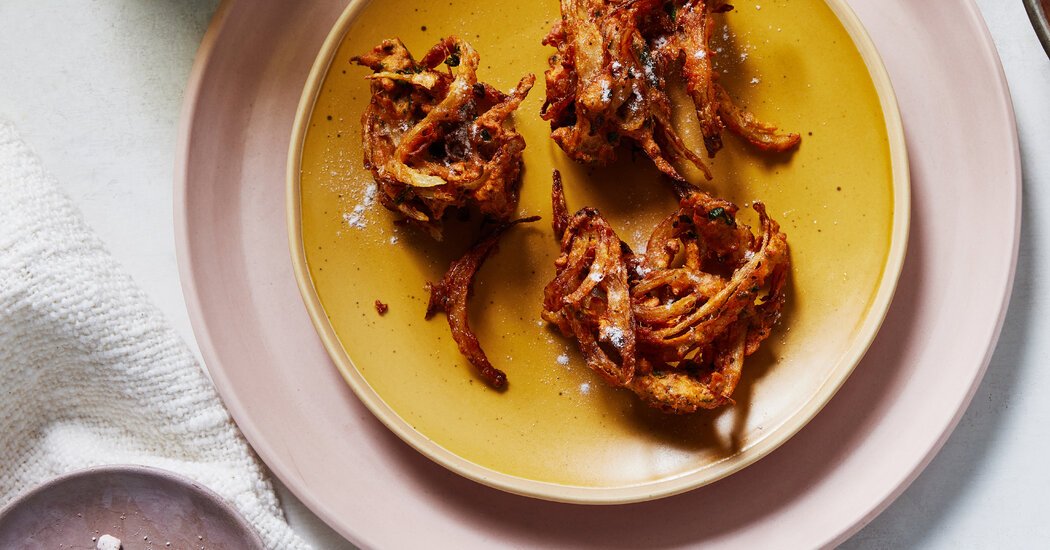[ad_1]
At the home of the cookbook author Palak Patel, the days leading up to Diwali are spent cleaning her kitchen and preparing the numerous snacks and mithai, or sweets, they’ll deliver to friends and family for the South Asian festival of light. Her mother, Mala Patel, fries dried snacks, like Mathia, to fill giant frosting buckets she repurposes from Dunkin’, where she works.
But the real treat comes on Nov. 12, during the height of Diwali celebrations, when guests visit Ms. Patel’s home in a suburb near Philadelphia and eat freshly fried onion bhajiya. It takes three people to efficiently prepare them: Someone mixes the batter with their hands and drops it in hot oil, another person keeps an eye on the browning fritters and Ms. Patel runs the hot onion bhajiya to guests, who dip them in cilantro chutney or ketchup.
Ms. Patel grew up eating the fritter for celebrations. “It’s always the gold-standard,” she said. She included her mother’s onion bhajiya recipe, which her mother ate during her childhood in Raipur, India, in her new cookbook, “The Chutney Life: 100 Easy-To-Make Indian-Inspired Recipes.”
During the five-day celebration of light, South Asians throughout the diaspora commemorate the holiday by decorating their homes, visiting friends and family, and gifting boxes of mithai or fried snacks that can be stored for weeks. People will typically eat one big Diwali meal in the evening.
Freshly fried snacks like onion bhajiya are served during Diwali in some parts of the country, especially in the north, said Monisha Bharadwaj, the author of several Indian cookbooks. But in other cities, the fritter is commonly made during monsoon season in June and served with masala chai.
Bhajiya can go by different names, too. Ms. Bharadwaj said that the fritters can also be called bhaji. The fritters are called pakoras if they’re made with other vegetables, like cabbage, potato or a mixture of spinach and cottage cheese.
Other traditional snacks include sweet, diamond-shaped shankrapali, samosas and spiral chakri or chakli, a crunchy, savory snack made from besan gram flour, said Nita Mehta, the author of many Indian cookbooks, including the “Diwali Cookbook.” Black lentil dal and a saffron-flavored sweet rice are commonly served for Diwali dinner.
In the past decade, Ms. Mehta said, Indians have integrated some global ingredients into their traditional cooking for Diwali. Some sweets are coated in white chocolate, for instance. Many people are now gifting boxes of store-bought sweets and snacks.
In the United States, many Indian Americans make Diwali catering orders through Facebook or WhatsApp. Urja Shukla Bhatt, of Warminster, Pa., has been taking catering orders for snacks and dinner since at least August. Her mother-in-law, Daksha Bhatt, helps make the snacks, but Urja Shukla Bhatt cooks the Indian dishes for dinner. The pair is expecting to make at least 20 items, including hundreds of samosas and more than 20 pounds of chakri.
Ms. Bhatt grew up watching her mother make these snacks, but she said that she learned a lot of techniques from her mother-in-law.
“Diwali is all about families and getting together,” she said. “It’s like a potluck.”
[ad_2]
